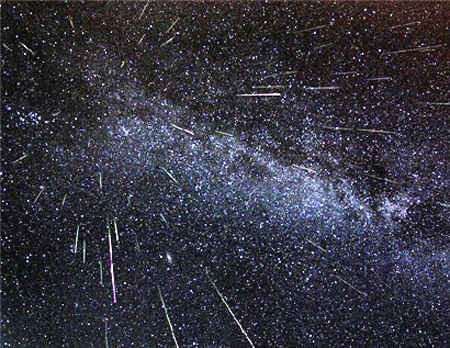
The Perseid meteors can be observed from August 9 through 17 in big cities in Vietnam. Astronomy clubs will organize observation of this interesting phenomenon.
The Perseid meteors can be observed from August 9 through 17 in big cities in Vietnam. Astronomy clubs will organize observation of this interesting phenomenon.
The most notable astronomic phenomenon in August 2011 is the Perseid meteor shower, one of the biggest meteor showers in the year, with the peak will be in the early morning of August 13th and 14th.
As the peak of the meteor show falls on the full moon time, moonlight will hinder observation. The Hanoi Amateur Astronomic Club organized observation at 8.30pm in Dinh village, in Tu Liem district, on August 9, said the club’s chair Truong Ngoc Khanh.
The astronomic club in the central city of Da Nang held the observation on August 10, on a hill in Lien Chieu district, at 5.30pm.
In HCM City, as the weather is unfavorable, the HCM City Amateur Astronomic Club does not hold any observation of meteor shower, says the club’s chair Dang Tuan Duy.
Dang Vu Tuan Son, chair of the Vietnam Young Astronomic Club, says that the moonlight may make the observation more difficult but at around 3am of August 13 and 14, the moon will gradually set to the west and it will not hinder observers. “If the weather is fine, observers can wait the peak of the meteor,” Son says.
Astronomers say that the idealist time for observation is after 12am, best at 2-4am.
The Perseid meteors were shed from the Comet Swift-Tuttle, at some point in the past, and appear to come from a point (called the radiant) in the constellation of Perseus. When they hit the atmosphere, they will be travelling at a fairly fast 60 kilometers per second. It is probably best to look about 50 degrees away from the radiant - the point where all the white lines seem to be coming from.
The meteors can be seen all across the sky, but because of the path of Swift-Tuttle's orbit, Perseids are primarily visible in the northern hemisphere. As with all meteor showers, the rate is greatest in the pre-dawn hours, since the side of the Earth nearest to turning into the sun scoops up more meteors as the Earth moves through space. The Moon spoils the party this year being in 100% waxing phase. The next two years are more favorable according to the Moon's phase.
The Perseid meteor shower has been observed for about 2000 years, with the earliest information on this meteor shower coming from the Far East. Some Catholics refer to the Perseids as the "tears of St. Lawrence", since 10 August is the date of that saint's martyrdom.
 |
As the peak of the meteor show falls on the full moon time, moonlight will hinder observation. The Hanoi Amateur Astronomic Club organized observation at 8.30pm in Dinh village, in Tu Liem district, on August 9, said the club’s chair Truong Ngoc Khanh.
The astronomic club in the central city of Da Nang held the observation on August 10, on a hill in Lien Chieu district, at 5.30pm.
In HCM City, as the weather is unfavorable, the HCM City Amateur Astronomic Club does not hold any observation of meteor shower, says the club’s chair Dang Tuan Duy.
Dang Vu Tuan Son, chair of the Vietnam Young Astronomic Club, says that the moonlight may make the observation more difficult but at around 3am of August 13 and 14, the moon will gradually set to the west and it will not hinder observers. “If the weather is fine, observers can wait the peak of the meteor,” Son says.
Astronomers say that the idealist time for observation is after 12am, best at 2-4am.
The Perseid meteors were shed from the Comet Swift-Tuttle, at some point in the past, and appear to come from a point (called the radiant) in the constellation of Perseus. When they hit the atmosphere, they will be travelling at a fairly fast 60 kilometers per second. It is probably best to look about 50 degrees away from the radiant - the point where all the white lines seem to be coming from.
The meteors can be seen all across the sky, but because of the path of Swift-Tuttle's orbit, Perseids are primarily visible in the northern hemisphere. As with all meteor showers, the rate is greatest in the pre-dawn hours, since the side of the Earth nearest to turning into the sun scoops up more meteors as the Earth moves through space. The Moon spoils the party this year being in 100% waxing phase. The next two years are more favorable according to the Moon's phase.
The Perseid meteor shower has been observed for about 2000 years, with the earliest information on this meteor shower coming from the Far East. Some Catholics refer to the Perseids as the "tears of St. Lawrence", since 10 August is the date of that saint's martyrdom.
(Source: Vietnamnet)





